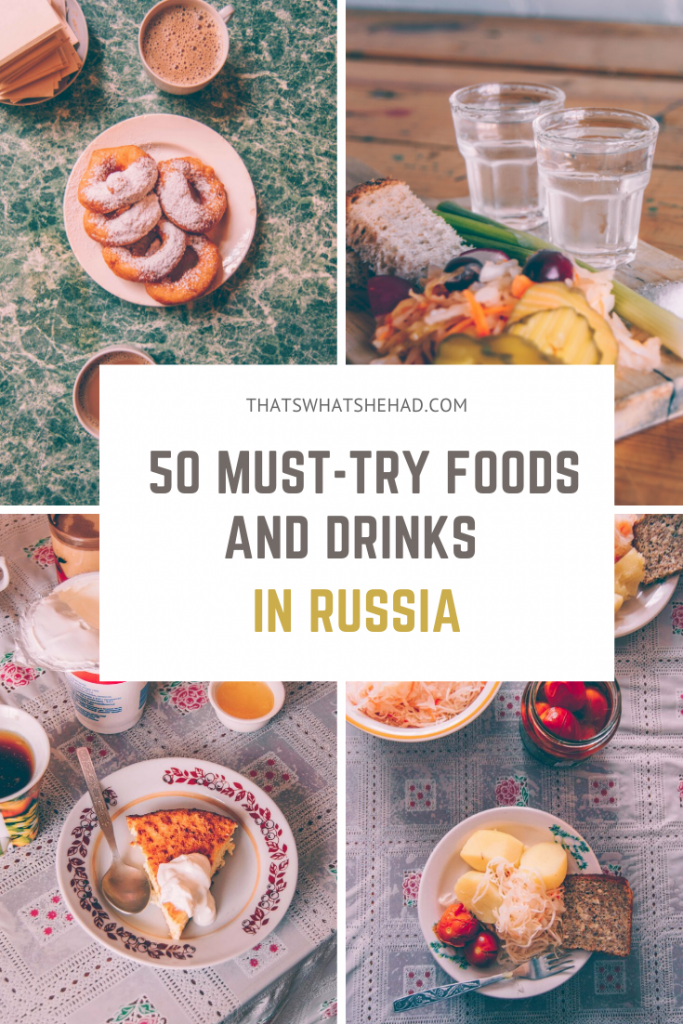I delayed writing this guide to Russian food for the longest time. I knew it would be a monster of an article. As a Russian, I know full well that Russian cuisine is much more than the suggested 10 dishes you usually find online. I mean, common! Have you seen the size of Russia on the map? With 10 dishes you won’t even scratch the surface.

Being a nerd that I am, I took the task seriously and came up with 50 traditional Russian foods and drinks one must try. Sounds intimidating? Don’t you worry, I am going to walk you through it! I divided all the dishes into categories: breakfast, appetizers, salads, soups, mains, baked goods, desserts, and drinks. Each category has only a handful of foods which makes it easy to digest (pun most definitely intended).
I am the kind of person who feels best prepared, and I assume, if you are reading this, you are too. Most likely you won’t try all 50 dishes on your trip, and that’s ok. This guide to Russian food is meant to help you feel less overwhelmed when you open a menu at a restaurant in Moscow, Saint Petersburg or wherever it is you are traveling.
But before we get into all the Russian dishes you must try, I’d like to say a few words about Russian cuisine, its history, and current state.

Russian Food is Regional
You will find herring under fur coat on New Year tables all over the country. You’ll also see people eating sirniki in the morning everywhere from Krasnodar to Kamchatka. However, every region has its specialties due to geographical location.
In the South, by the Black Sea, you’ll find plenty of fish, fruits almost year-round, nuts and spices. In the Far East, it’s all about crab, mussels, and scallops. In Siberia, game is king: from deer to elk to bear meat. And in the fancy restaurants of Moscow and Saint Petersburg you can find all of the above and more, of course.
In this guide you’ll find dishes that are popular all over Russia. If I were to include regional specialties, the name of the article would be “350 must-try Russian foods”.
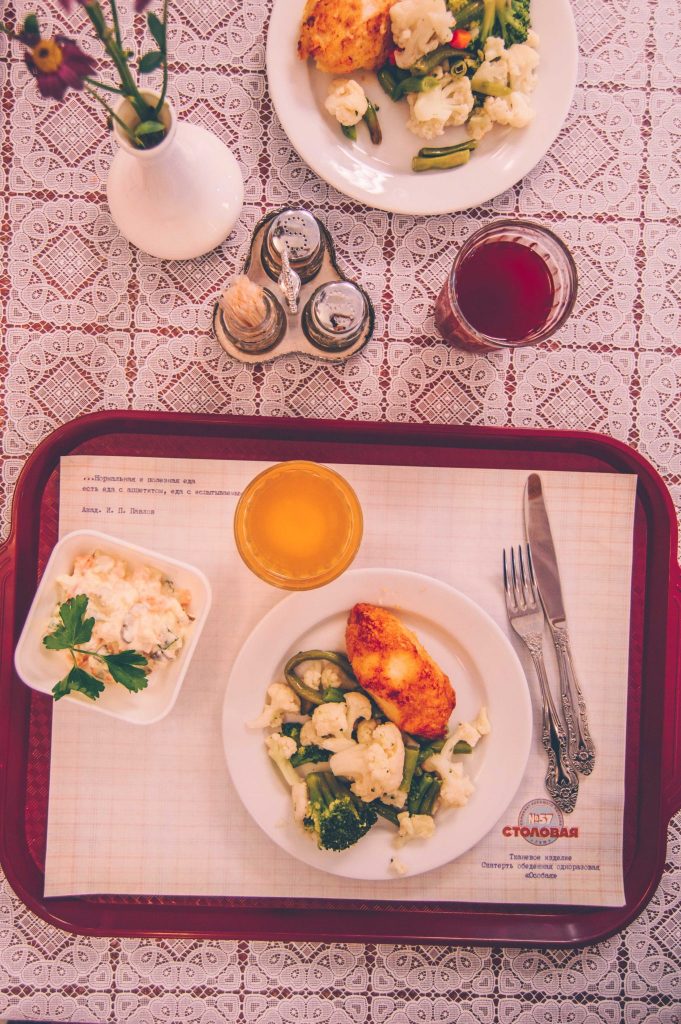
Royal vs Soviet
Many Russian foods that are famous around the world take their roots in Soviet history. From herring under fur coat to pirozhnoe kartoshka, Soviet dishes were born in scarcity. When the only way to get butter or cheese is by obtaining a ration card, one has to get creative.
Salads, for example, were made by combining everything that could be found in the fridge. Layer a bunch of different vegetables, add a little bit of meat or fish, glue it all together with mayo — you got yourself a Russian salad. Or take the aforementioned pirozhnoe kartoshka, a popular Soviet dessert. It was invented to reduce wastage in bakeries by using up cake cut-offs and crumbs.
But come to think of it, Soviet Union existed only for seventy years. For centuries before that Russia was an empire governed by tzars, and so, from ingredients to kitchen tools to preparation techniques, the food was drastically different. Nowadays, it is hard to find dishes form that era on the tables of Russian people. However, modern chefs make efforts to seek out pre-revolution recipes and recreate them.
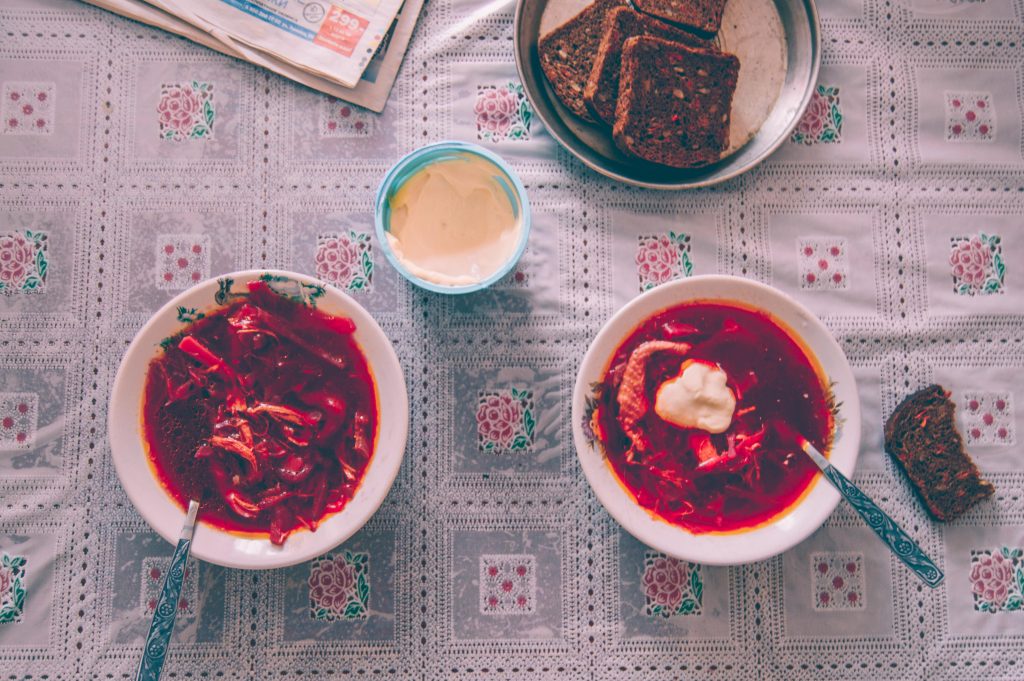
But Is It Really Russian Food?
Speaking of Soviet heritage in Russian food, I have to talk not only about scarcity, but about diversity too. There were 15 republics in Soviet Union, each with its unique cuisine. People travel, and food travels with them. Which is why you will find Belorussian draniki, Uzbek plov, Ukrainian vareniki, and Georgian harcho-soup in many Russian homes. I included some of these dishes here, with a note on their origins.
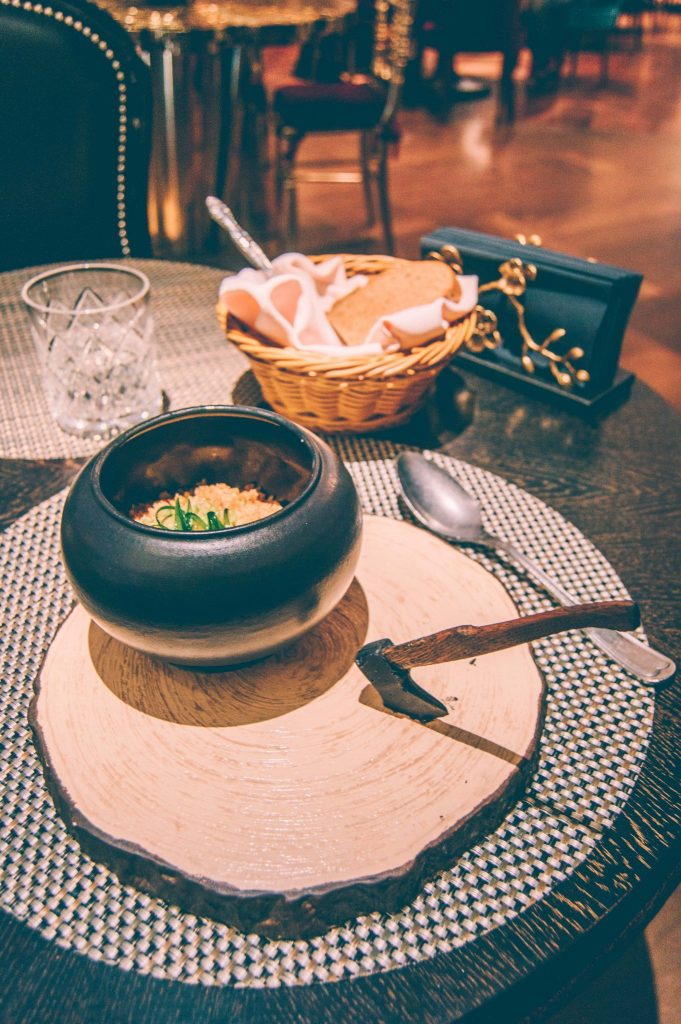
New Russian Cuisine
One last note on Russian food in 2020! Dining in Russia is getting more exciting by the day. I always say that we are going through gastronomic Renaissance, and new Russian cuisine is as progressive and thrilling as the new Nordic cuisine.
Russian chefs are finally looking inward, into our traditions and history, to create uniquely Russian dishes. After years of copying the West and using imported ingredients, we are finally free of pasta carbonara and tiramisu in every cafe. Today, herbs and berries from Altai, crab from Kamchatka, and edible moss from Karelia are what everyone’s after.
This guide is all about traditional Russian food, but I highly recommend you visit a modern Russian restaurant on your trip. Here are my favorite Russian restaurants in Moscow and here you can read about the restaurants I loved in Saint Petersburg.
That was one long introduction! Now let’s get to Russian foods you must try on your visit!
50 Russian Foods You Must Try on Your Trip
Breakfast
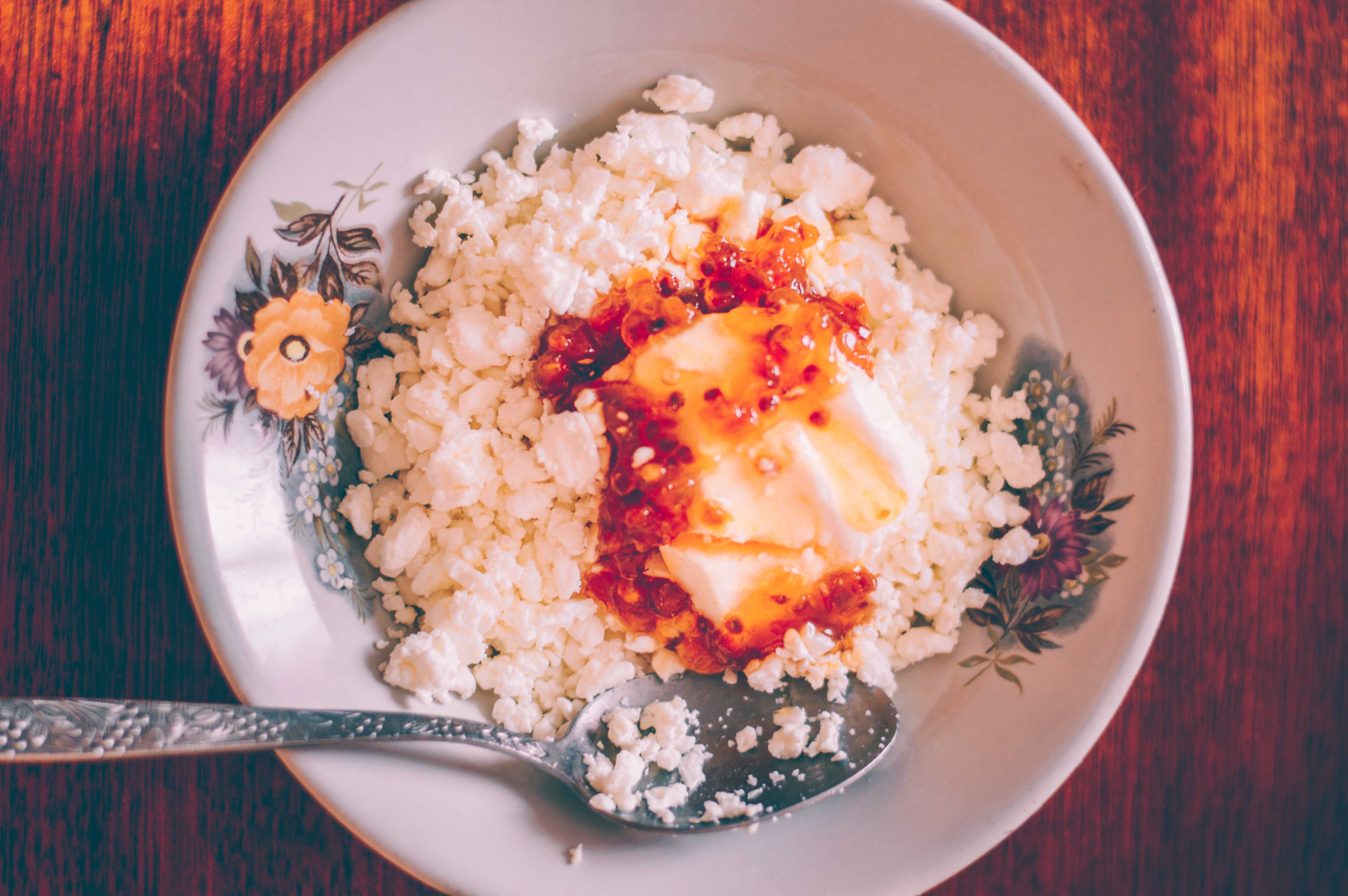
- Tvorog (Cottage Cheese) with Sour Cream and Jam
High-quality fatty tvorog mixed with sour cream — none of that fat-free BS — is my personal favorite for breakfast. Add some homemade vareniye (jam) for a sweet punch and enjoy. It’s easiest to get tvorog at a supermarket. And if you are not in Russia yet, but cravings kicked in, use my tried-and-true tvorog recipe.
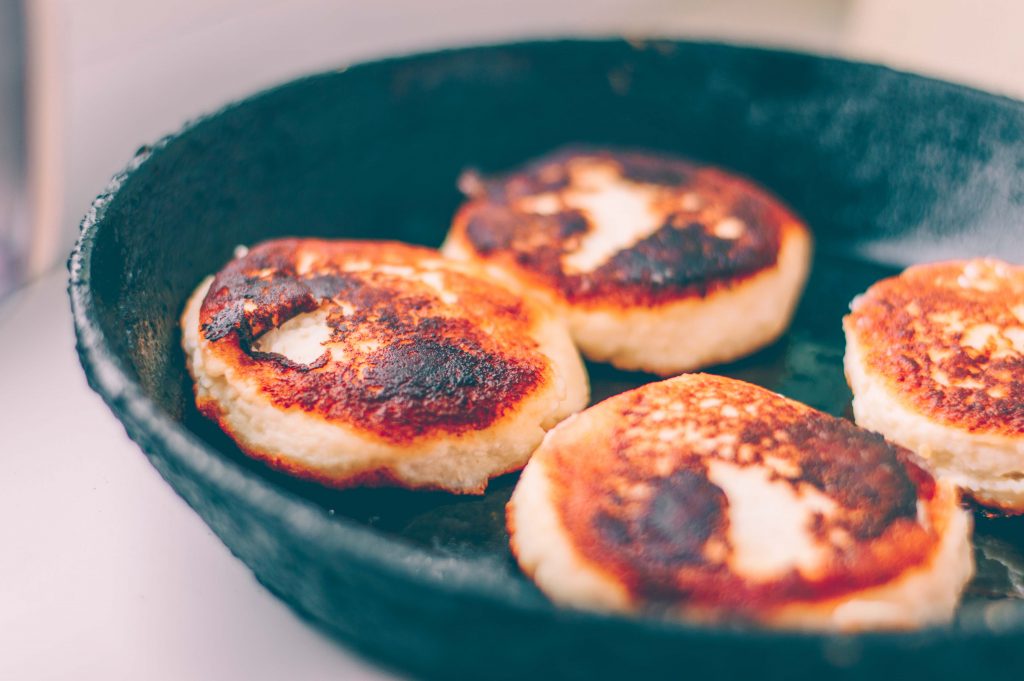
- Sirniki
Now, if you prefer your cottage cheese cooked, sirniki is the way to go. Sirniki are cottage cheese patties that can be fried on a pan or baked in the oven. They are usually served with sour cream and jam, but some restaurants get creative and offer them with caramel sauce, sweetened condensed milk and the likes. By the way, I’ve got a recipe for sirniki too.

- Zapekanka
While we are on the topic of cottage cheese, here’s another variation: zapekanka. Think of it as a cottage cheese cake. The ingredients are similar to that of sirniki: tvorog, eggs, sugar, semolina, and raisins. Zapekanka usually has a nice crust on the outside and soft, silky-smooth center. It goes well with custard sauce, condensed milk or sour cream.

- Blini and Blinchiki
The quintessential Russian dish, blini are thin pancakes fried on a pan. Back in the day, the pan would go into pech — a typical Russian stove that was used for both cooking and heating up the house. Nowadays, modern stoves do just fine. Blini are best enjoyed with lots of melted butter, sour cream (we use it on everything), and vareniye (jam).
By the way, if you visit Russia in February-March, you can attend Maslenitsa, a festival that celebrates the end of winter. During the week of Maslenitsa, Russians make blini every single day. On Sunday, people gather in city squares to welcome spring and eat hot blini that represent sun and warmth.
As for blinchiki, these are simply blini stuffed with a filling. It can be anything from minced meat to cottage cheese to berries.
- Oladushki
Oladushki are similar to blini in substance, but different in shape. If blini are large and thin, oladushki are small and thick. Eat them with sour cream and vareniye (jam). But you’ve already guessed that, right?
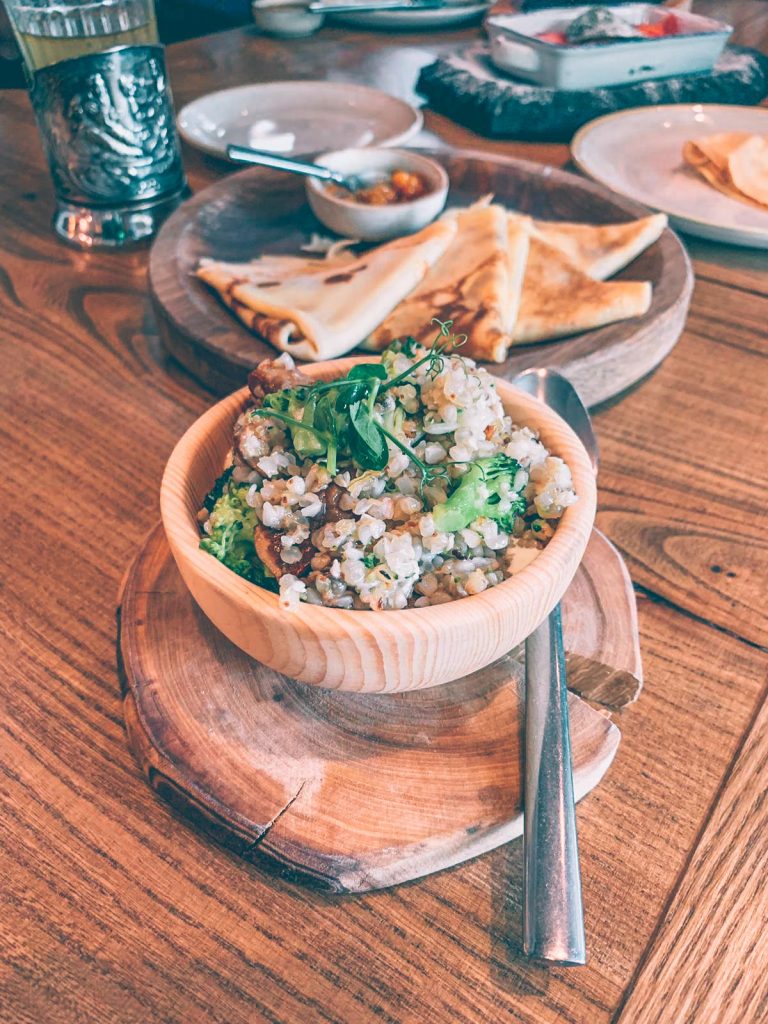
- Buckwheat Kasha (Porridge)
Buckwheat porridge is a typical Russian food that can be served both sweet and savory. Sweet kasha is prepared with milk, while savory one can be mixed with vegetables, mushrooms or meat. Either way top it with lots of butter!
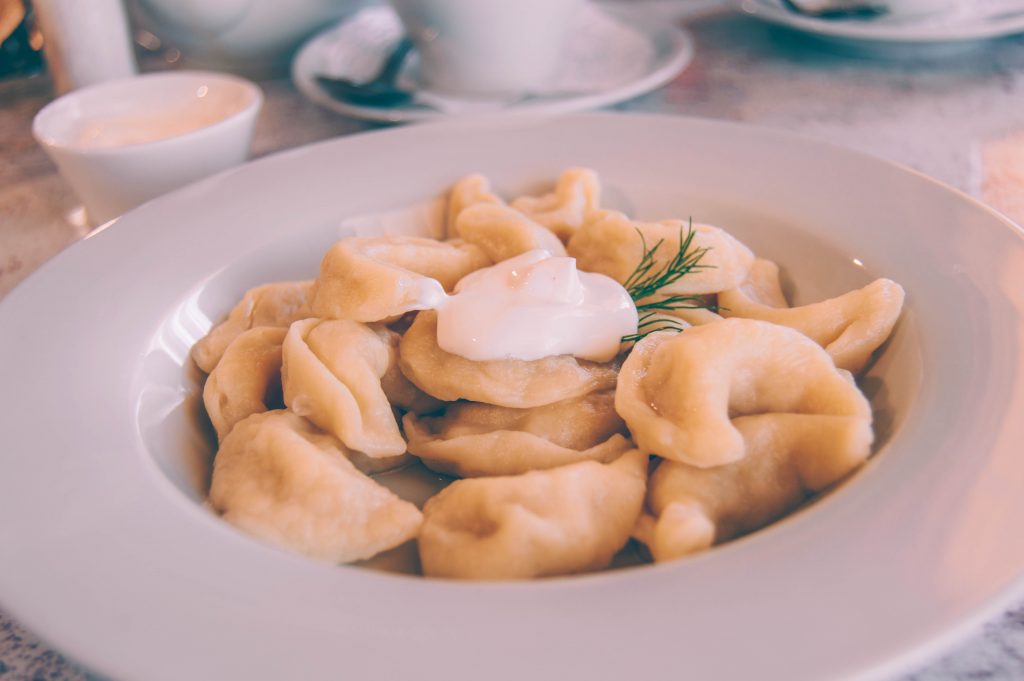
- Vareniki
Vareniki are half-moon-shaped dumplings, stuffed with anything from potato to mushrooms to cottage cheese to berries. Originally Ukrainian, they are popular in Russia. One of my favorites is vareniki with cherries and sour cream.
Appetizers
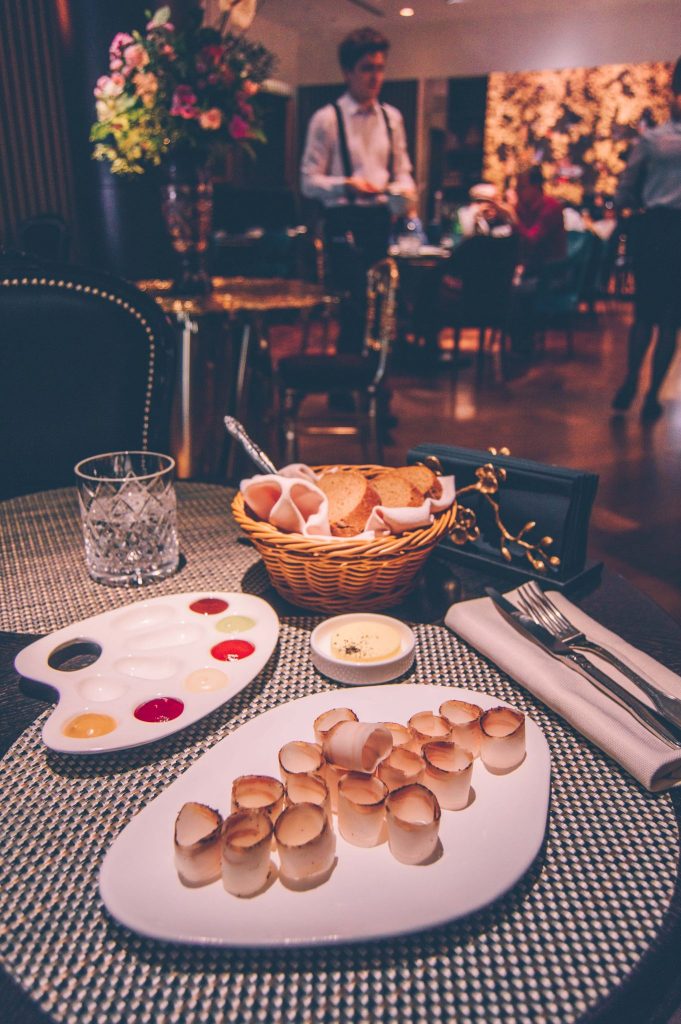
- Salo (Pork Fat)
Another Ukrainian specialty that has a strong presence in Russian cuisine is salo, or cured pork fat. Now, I know how it sounds, but it’s one of the most amazing foods you can try in Russia. Served thinly sliced and sprinkled with pepper, salo goes well with rye bread.
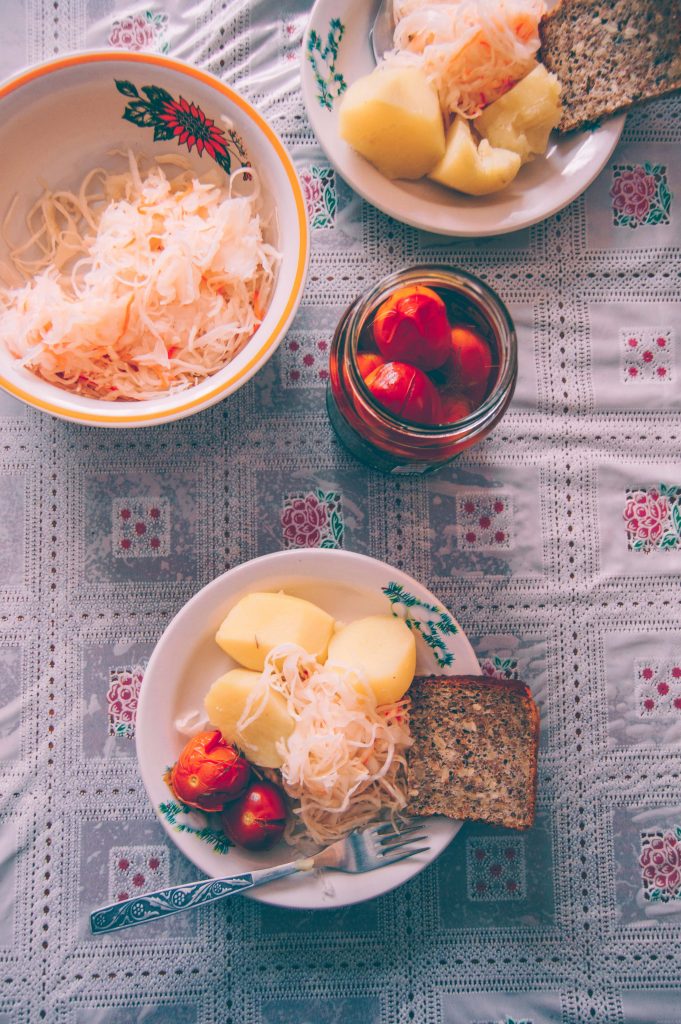
- Pickles
Russians pickle everything: from tomatoes to cabbage to cucumbers to even mushrooms! You can eat them with boiled potatoes or on their own as an appetizer. Pickled cucumbers also work perfectly as a chaser after a shot of vodka.
- Caviar
The most Russian of all Russian foods is, without a doubt, caviar. At least in the eyes of foreigners. In reality, black (sturgeon) caviar is so expensive that I probably had it only once in my life.
Red caviar (salmon roe) is more affordable, but it’s still not a common food to have in one’s fridge. So if you can splurge on caviar, by all means, do it! Meanwhile, I will stick to zucchini. Oh, wait, I need to explain this one.
For some reason, we call preserved zucchini puree “zucchini caviar”. It’s doesn’t look cool on Instagram pictures or pair well with champagne, but it’s delicious and cheap. What more can you ask of zucchini?
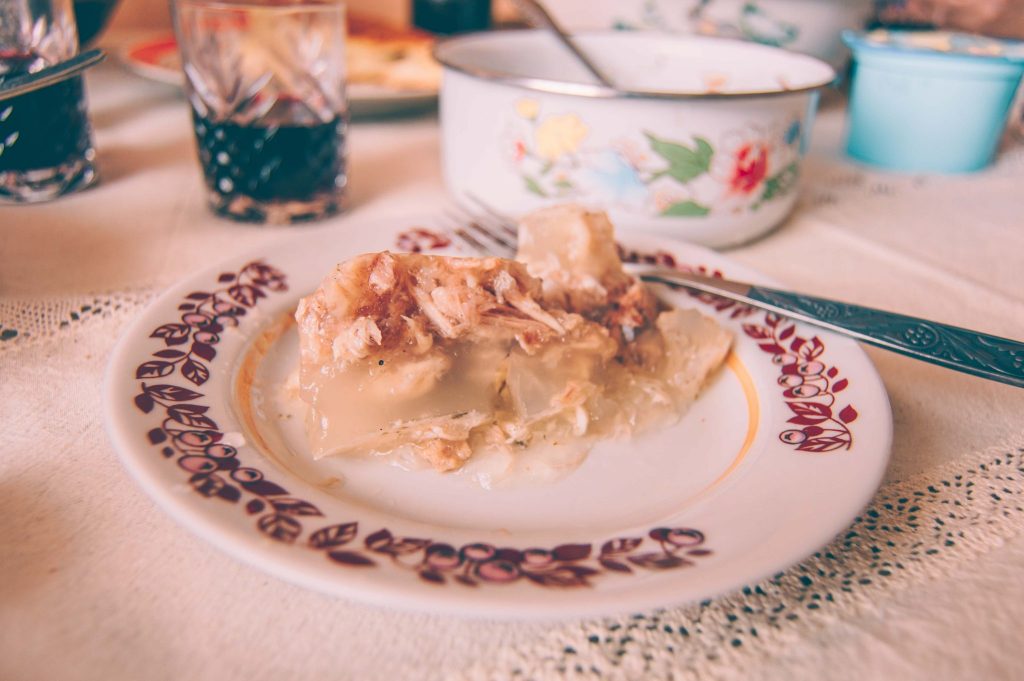
Kholodets and Zalivnoye
Kholodets and Zalivnoye
If you thought salo (cured pork fat) is as far as we can go when it comes to weird foods, let me introduce you to kholodets. Here’s how you make it: take all the meat you usually throw into garbage (like chicken feet, beef tongue, or pig’s head), boil it to get fatty stock, season to taste, pour the stock and meat pieces into serving plates and leave to set.
The coolest thing about kholodets is that you need no gelatin for it to set. Connective tissues in meat have so much collagen that kholodets sets on its own. If you are willing to make it yourself, I have a recipe with pictures (not for the faint of heart!).
Zalivnoye is a cousin of kholodets. The main difference is that zalivnoye is prepared with whole slices of meat, fish, vegetables or eggs, as opposed to bits and pieces in kholodets. Zalivnoye, therefore, looks more presentable.
- Stroganina
Another Russian food that might surprise you is stroganina, thin slices of frozen raw fish or meat. It comes from the North of Russia and is a typical dish in Yakutia and Komi Republic.
The best stroganina is made of muksun, omul, or nelma caught during winter months. When it comes to meat, the most popular variety is venison. To be completely honest, this is the one dish on this guide to Russian food that I am yet to try myself! So if you taste stroganina on your trip, do let me know in comments how it was!
- Buzhenina
Buzhenina is a large piece of roasted pork, thinly sliced and served as an appetizer. Russian buzhenina has cousins in other cuisines, for example, schweinsbraten in Germany or roast beef in England. But what sets it apart is the use of kvas in marinade. We’ll talk more about kvas in the drinks section of this guide to Russian food. For now, suffice it to say, that kvas is a fermented drink made of rye bread.
Salads
- Herring Under Fur Coat
One beloved by Russians dish that most foreigners find unappealing is herring under fur coat. The bottom layer of this salad is pieces of pickled herring fillet, which are covered by a “fur coat”: onions, carrots, potatoes, eggs, and beetroot. To bring the layers together one needs shocking amounts of mayo.
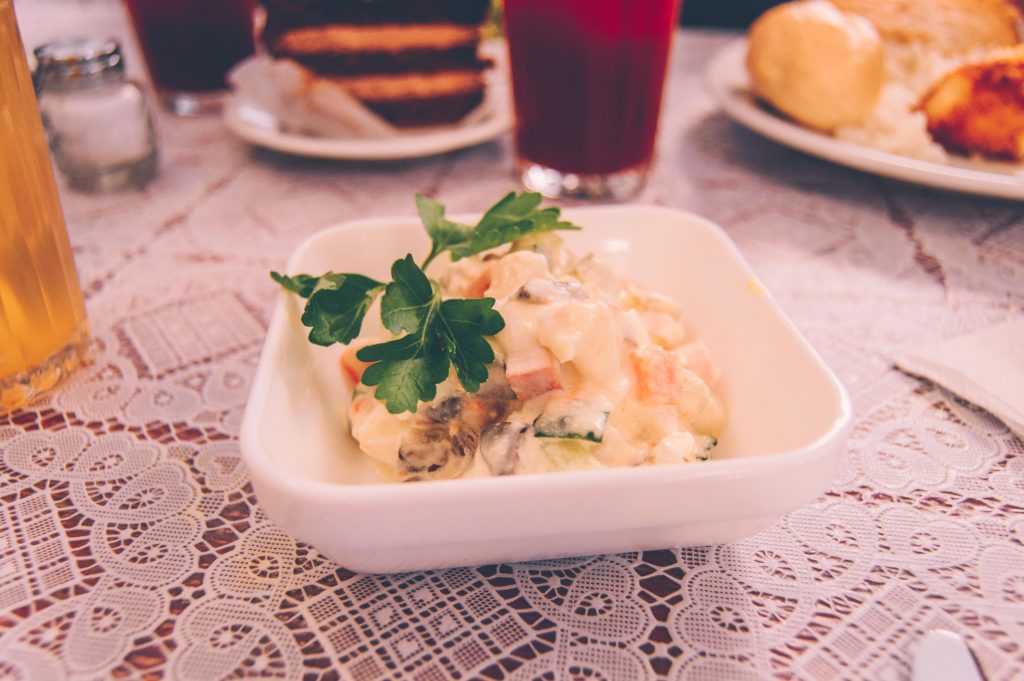
- Olivier
You probably know this dish by the name “Russian salad”. In Russia, of course, nobody calls it “Russian salad”. It’s either “Olivier” or “Winter salad”. Traditionally, it’s prepared with boiled potatoes, eggs, pickled cucumbers, green peas, and some kind of meat.
The original recipe features boiled beef. However, in my family we always make it with bologna sausage. If you wonder what kind of dressing goes into Olivier, it’s mayo, duh!
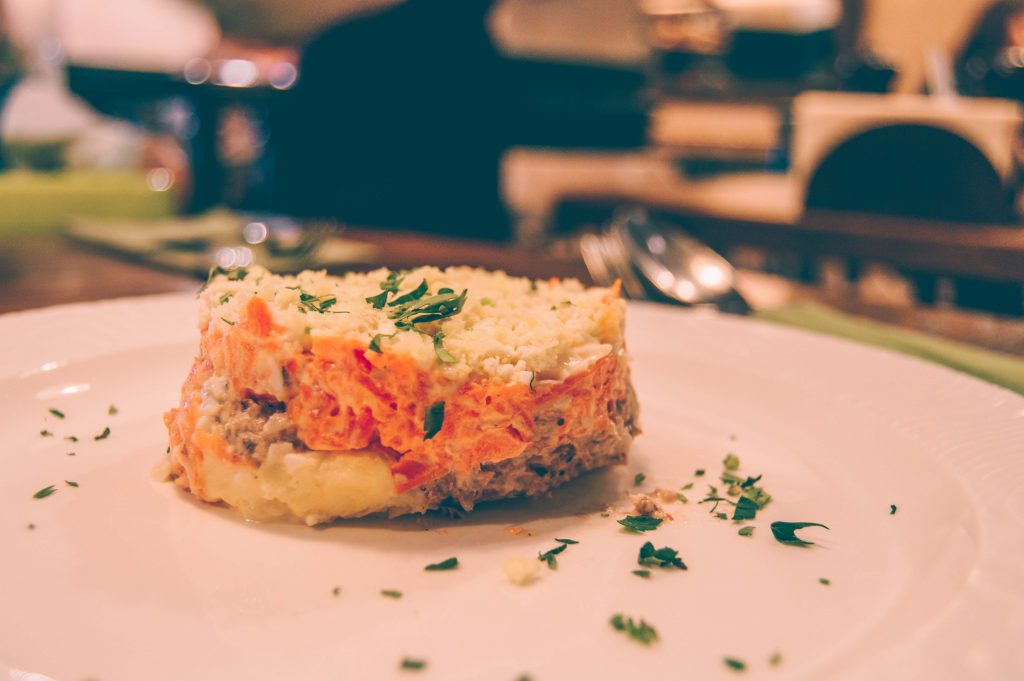
- Mimosa
No, it’s not a drink! We are still on the topic of salads. Mimosa is a layered salad prepared with tinned fish. Boiled eggs for the salad are separated into egg whites and yolks. Grated egg whites make up an inner layer of the salad, while grated egg yolks go on top. That’s where the salad got its name. The bright-yellow top layer resembles mimosa flower. What do we smother on top of each layer? Mayo! We love mayo and we are not afraid to say it!
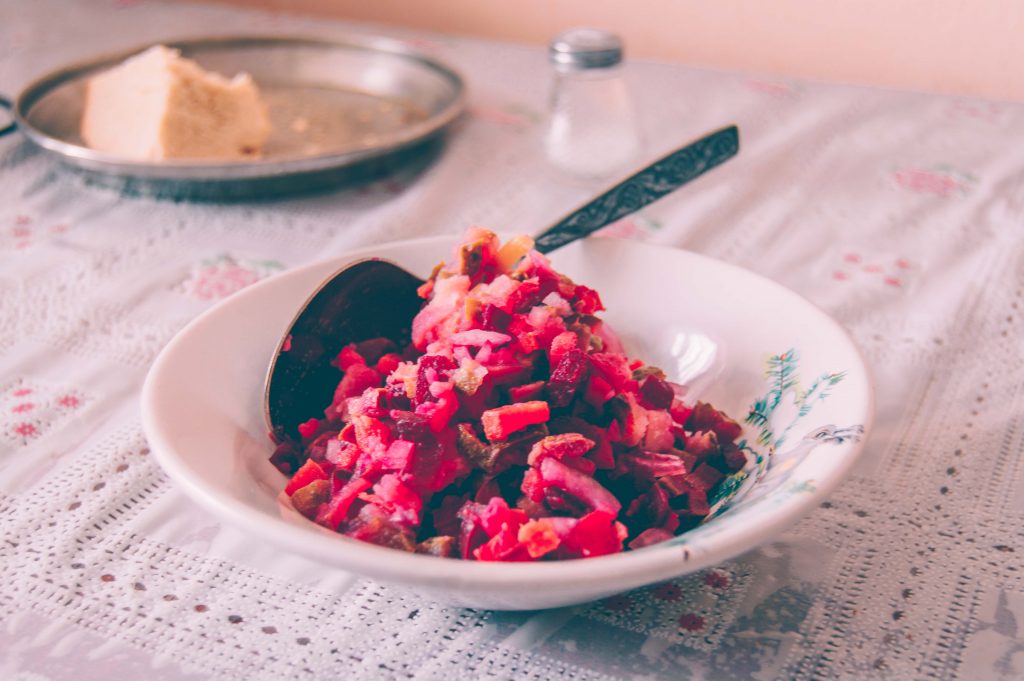
- Vinegret
Possibly, the only salad that doesn’t have any mayo in it. I know, I am shocked too! Vinegret is a simple mix of boiled vegetables with sunflower oil as dressing. Boiled beetroots give the salad its distinct bright red color, while pickled cabbage (or cucumbers) add a sour punch.
Soups
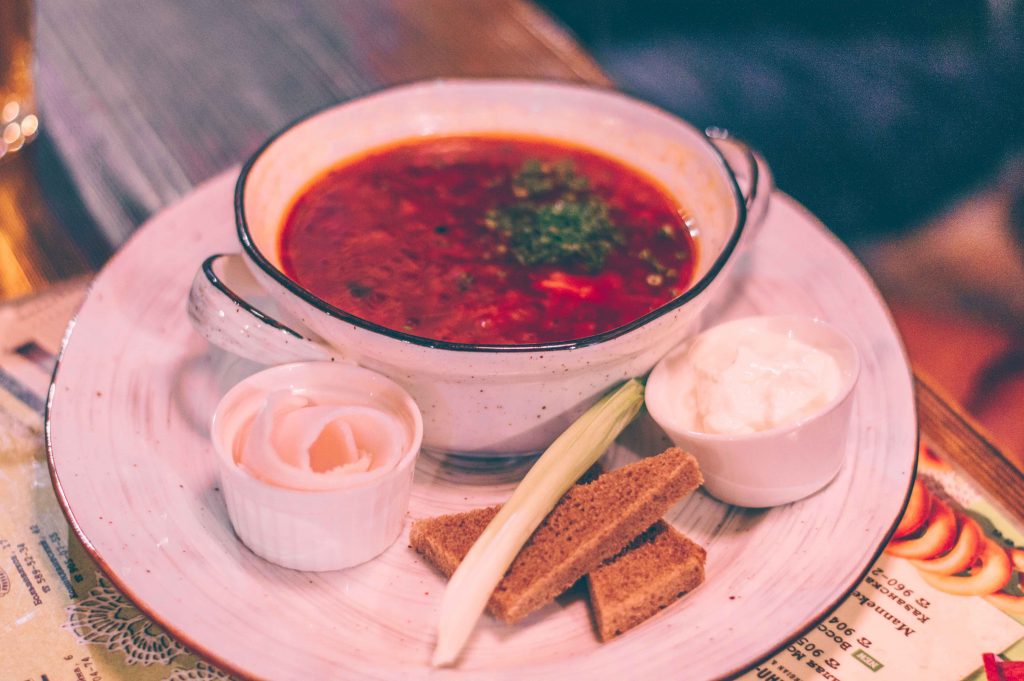
- Borsch
Along with caviar, borsch is what most foreigners think of when it comes to Russian food. Originally Ukrainian, borsch has become a staple in Russian kitchens. This hearty beetroot soup is perfect for cold winter days. Ukrainian version of borsch is served with pampushki (garlic bread rolls) and salo (cured pork fat).
- Shchi
Shchi is a hearty cabbage soup. The original recipe calls for fresh cabbage, however pickled cabbage (sauerkraut) can also be used. When made with sauerkraut, the soup is called sour shchi. In summer, when greens are in abundance, one can substitute spinach or nettle for cabbage. Then it’s called green shchi.
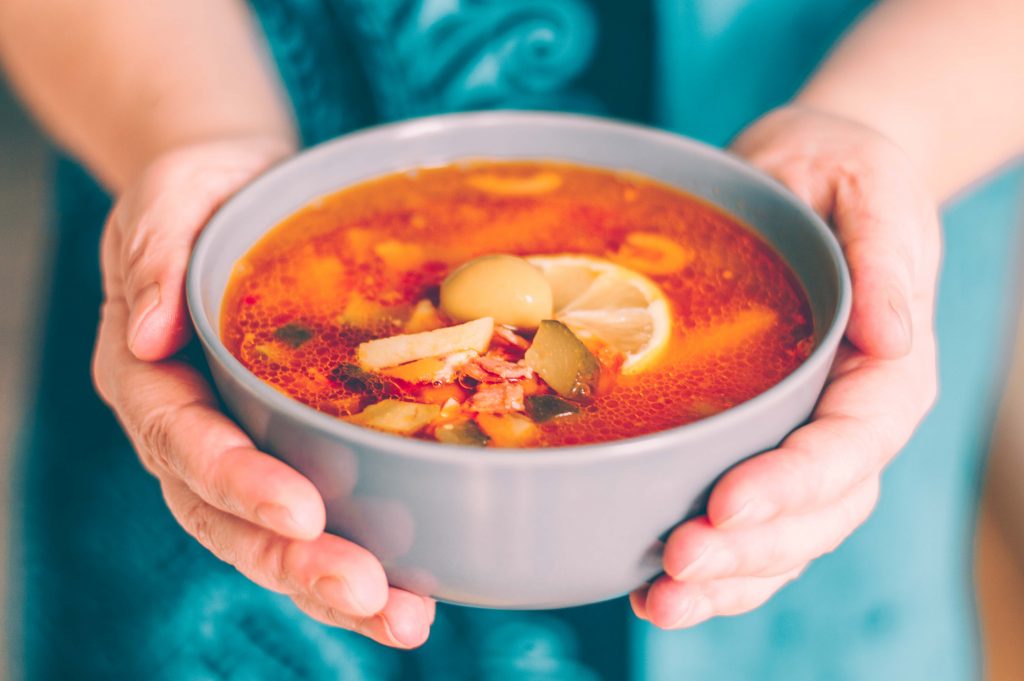
- Solyanka
The word solyanka has two meanings in Russian: the name of the soup and “a mix of everything”. The ingredient list of solyanka is indeed a mix of everything. But mostly, of all kinds of meat.
When my mom prepares solyanka at home, the rule is to use at least 4-5 types of meat: from chicken breast to salami to ham to bologna. The more diverse the better. Pickled cucumbers, olives, and lemon juice add a sour punch to this soup. Add sour cream or mayonnaise to taste. Yes, mayonnaise goes into soup, nothing weird about it.
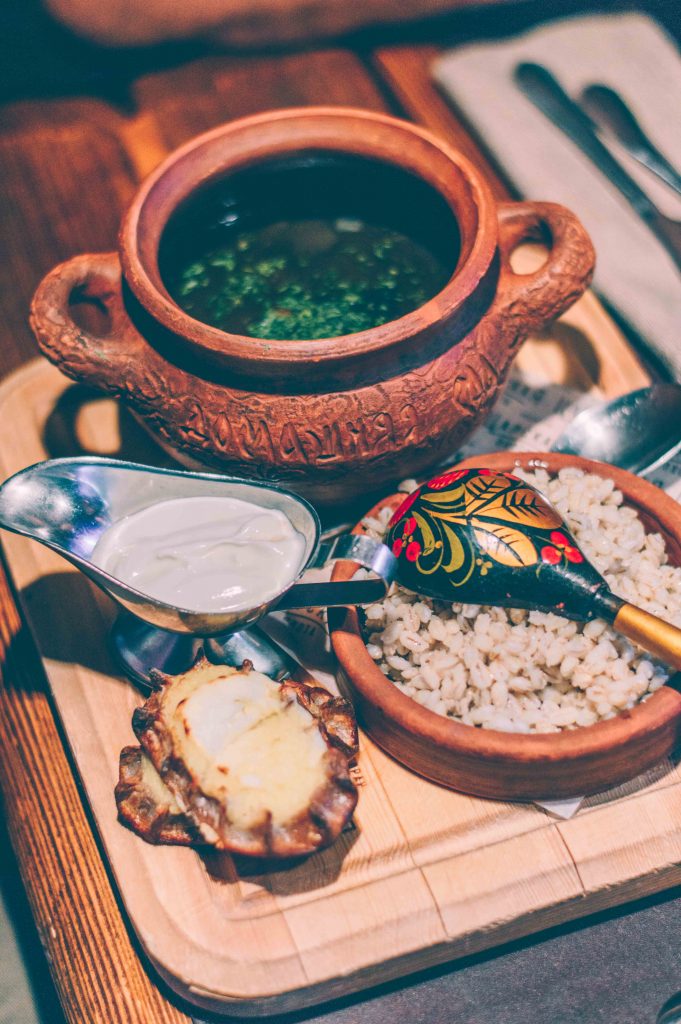
- Rassolnik
I am running out of words to describe all the soups we consume in Russia, so I’ll be brief. The main ingredients in rassolnik are pickled cucumbers and pearl barley. The base is beef stock. Don’t forget to add sour cream or mayo.
- Gorohoviy
Gorohoviy soup is a simple yellow lentil soup. But there’s a kick! The stock is made with smoked pork ribs which are usually left whole in the soup. The best part is eating meat off the ribs after you finish your plate of gorohoviy.
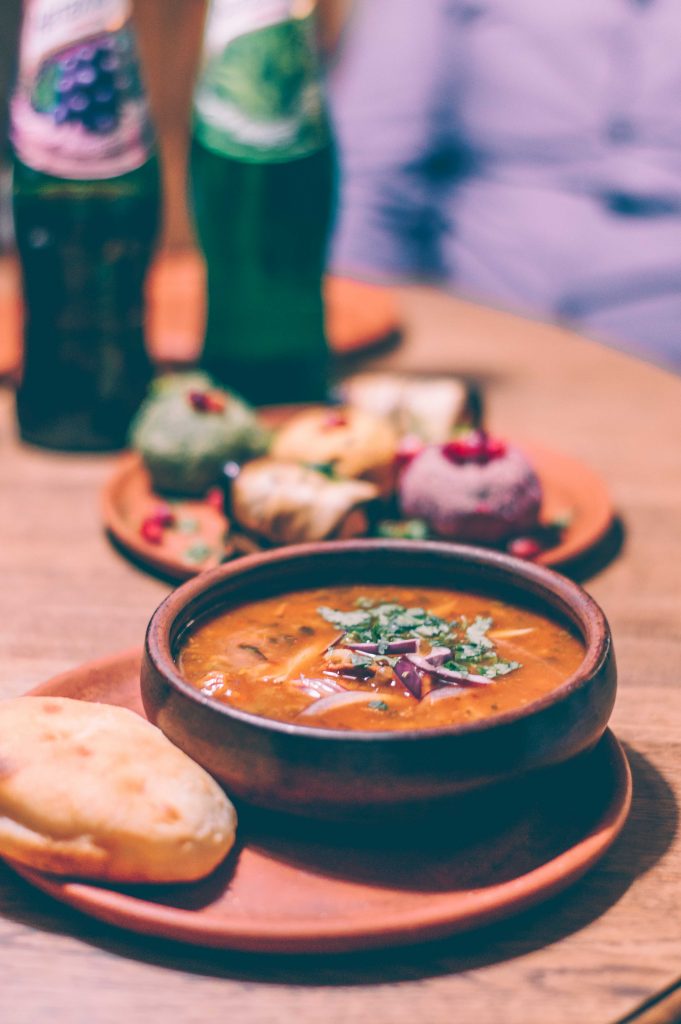
- Harcho
A thick hearty Georgian soup made with beef, rice, walnuts, and plum sauce. One of the most prominent ingredients is garlic that adds a spicy kick to harcho.
- Ukha
Ukha is a fish soup made with clear stock. If you are lucky enough to experience fishing in Russia, it is common for fishermen to cook ukha with freshly-caught bream or pike over fire right at the river bank.
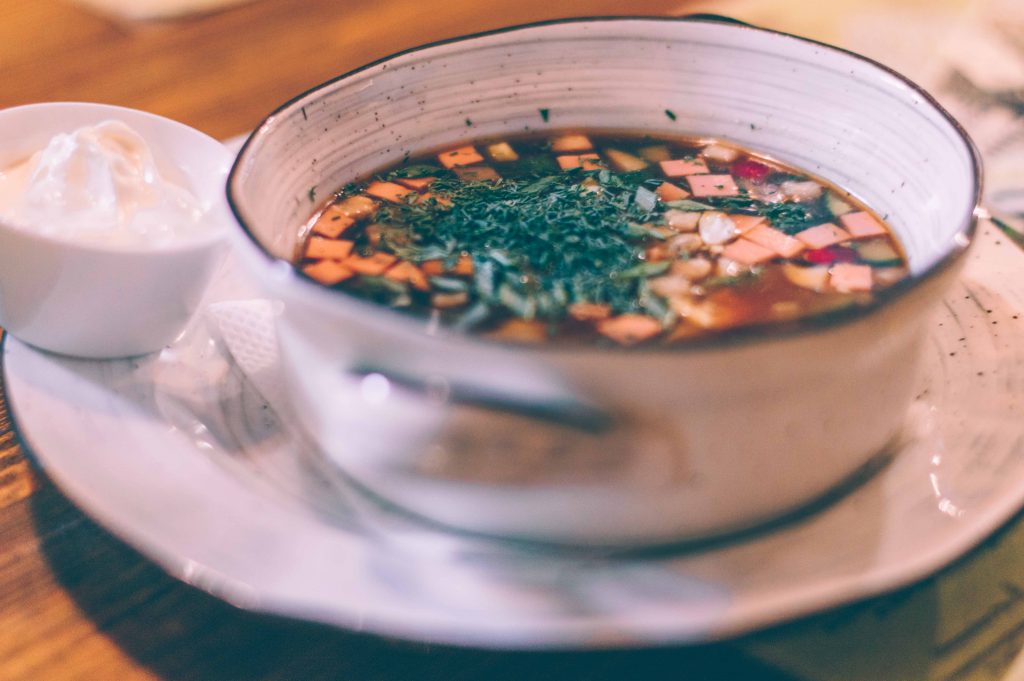
- Okroshka
While most Russian soups are consumed to warm up in the fall-winter period, we have a few that are perfect to cool down in summer. That’s right, Russians are so hardcore we cool down with soup, not Coca-Cola.
Okroshka is essentially a salad made with vegetables, boiled eggs, and bologna. Once the salad is ready, pour cold kvas (fermented drink) over it, and you got yourself a nice refreshing soup. Alternatively, okroshka can be made with some kind of dairy drink, like kefir or whey.
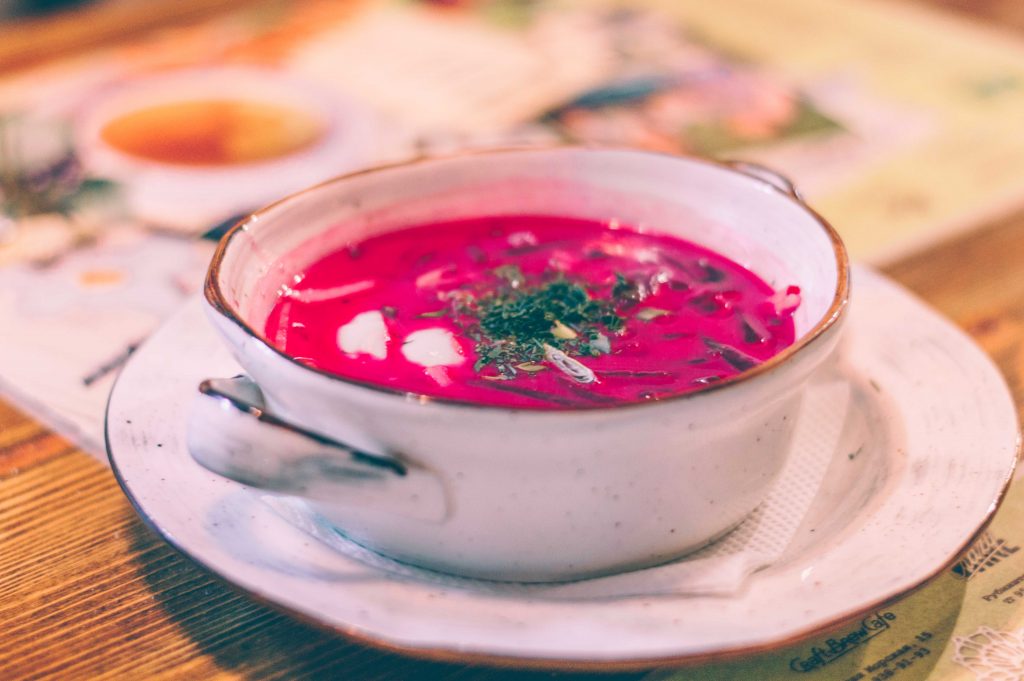
- Svekolnik
Another cold summer soup is called svekolnik. The soup got its name from the word “svekla” which means beetroot. Apart from beetroot, it also featured cucumbers, boiled eggs, bologna, and greens (like dill, spring onions, and parsley). Make a salad first. Pour kefir over salad. Add sour cream or mayo. But you already know that, right?
Mains
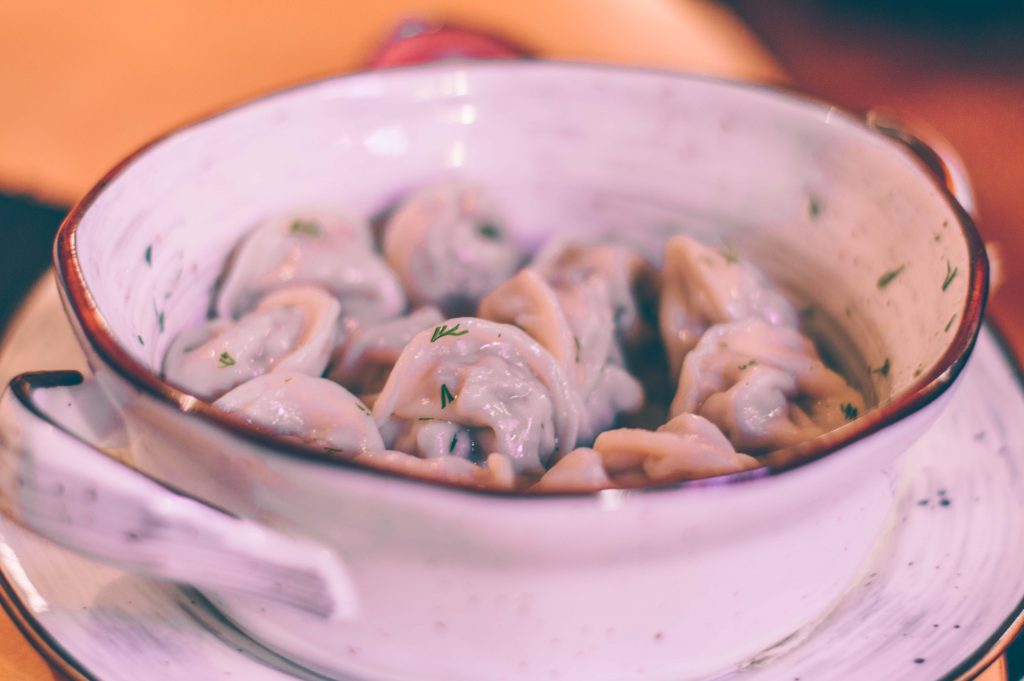
- Pelmeni
Pelmeni are a Russian cousin of Ukrainian vareniki. Made of unleavened dough, pelmeni are stuffed with ground meat and boiled. They can be served with a little bit of stock they were cooked in.
When it comes to sauce, you have plenty of options: from sour cream to mayo to mustard to diluted vinegar (no kidding) to butter. Do not use ketchup on your pelmeni, though. It’s disgusting.
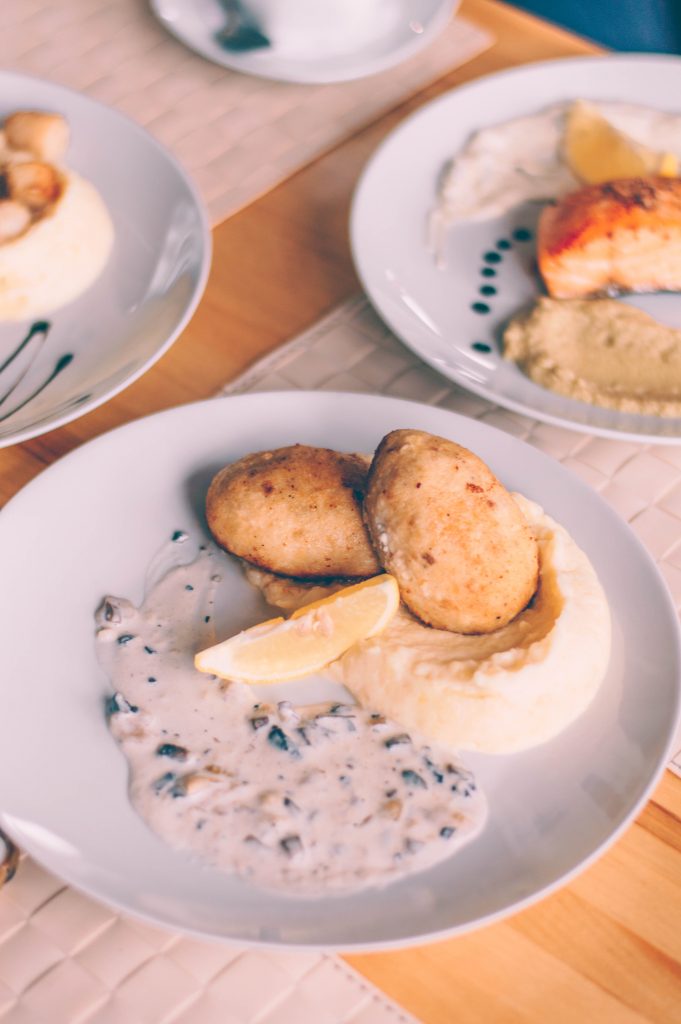
- Kotleti (Cutlets)
Kotleti are fried cutlets made of ground meat or fish. Meat kotleti are prepared with beef, pork, chicken or a combination of the above. As for fish, pike is probably the most popular variety, but you can also find cod or pollock cutlets. Kotleti are served with a side of rice, buckwheat, or potato.
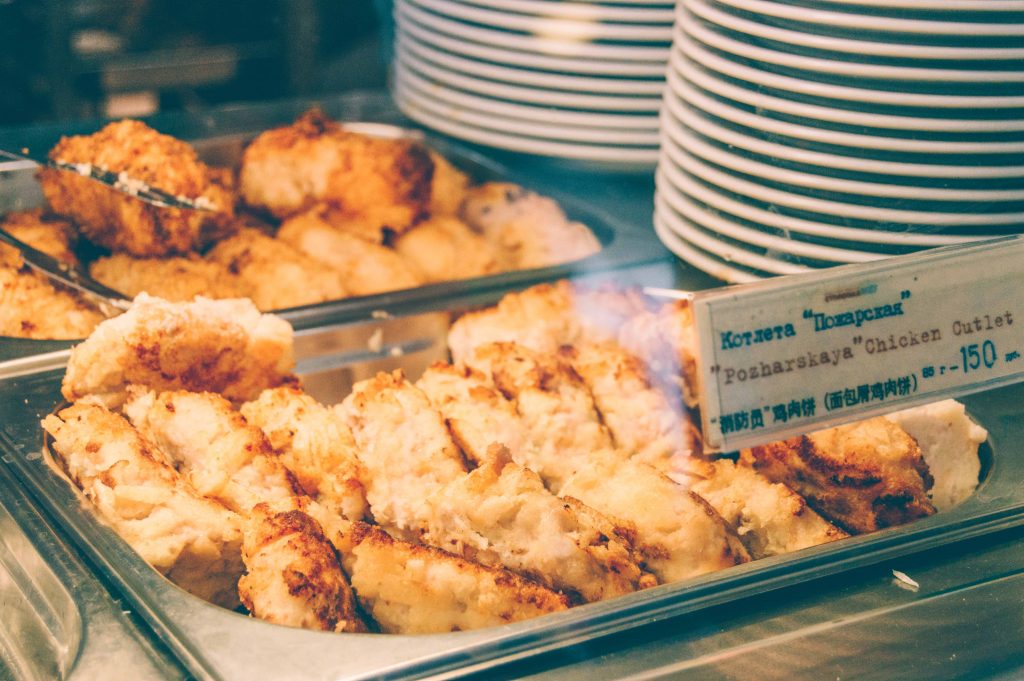
- Pozharskaya Kotleta
A variation of traditional cutlet, Pozharskaya kotleta is made of ground chicken or veal. There are two distinct differences between regular kotleti and Pozharskaya kotleta. First of all, when making the latter one adds lots of butter to the ground meat. Second, before frying, the cutlets are dipped into bread crumbs. As a result, Pozharskaya kotleta is juicy and tender on the inside and crispy on the outside.
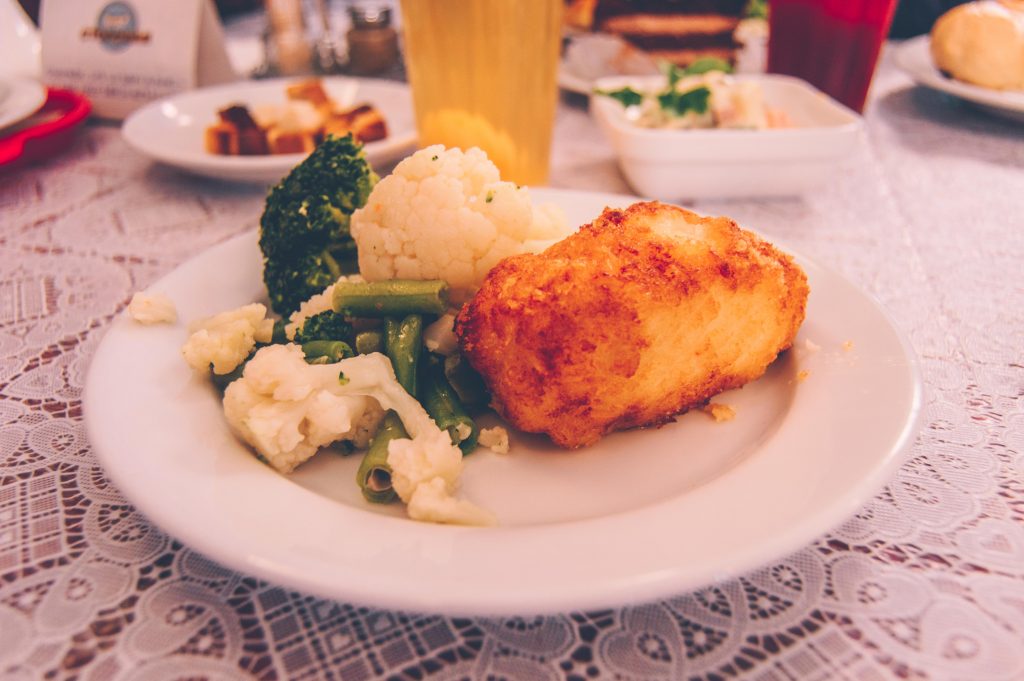
- Chicken Kiev
In Russian this dish is called Kiev-style kotleta, not Chicken Kiev, although the recipe does not call for ground meat. Quite the opposite: Chicken Kiev is prepared with a whole chicken breast fillet with wing-bone left in.
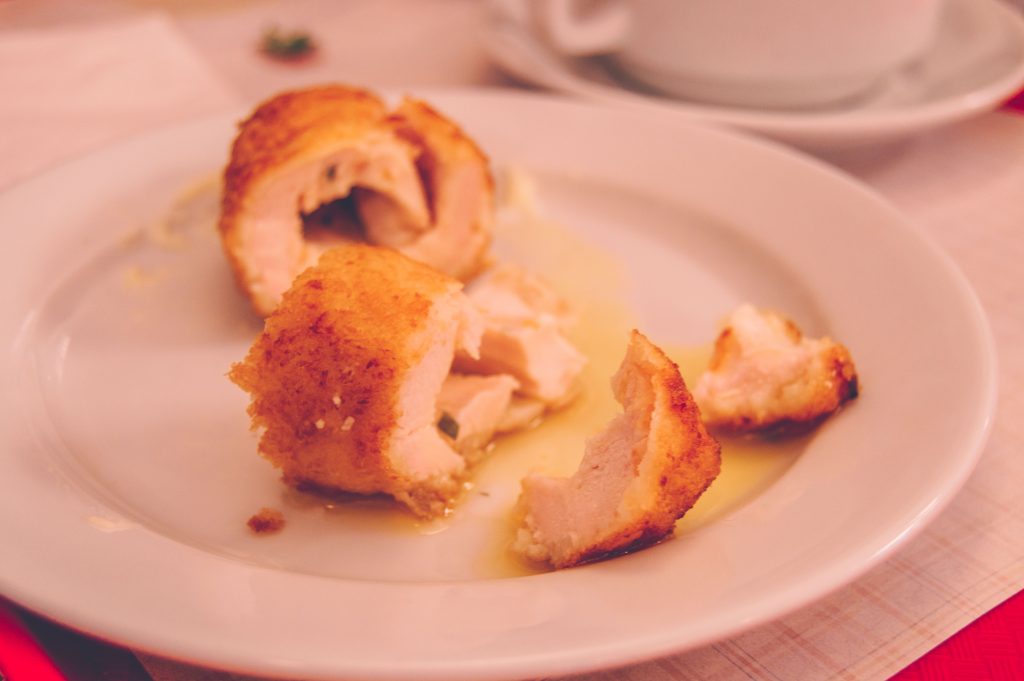
The fillet is cut open, pounded and stuffed with a piece of butter. Then it is rolled up, covered in bread crumbs and deep-fried. You know Chicken Kiev is done right when butter oozes out once you cut it.
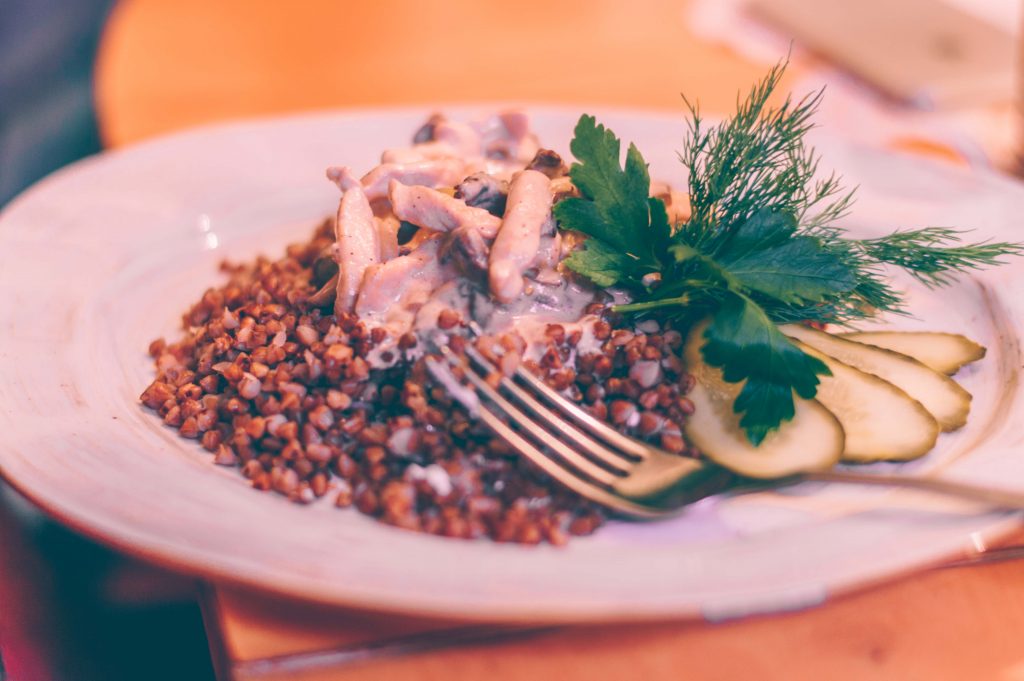
- Beef Stroganoff
One of the most popular Russian foods abroad, along with blini and caviar, is Beef Stroganoff. Thinly sliced pieces of beef tenderloin or sirloin are cooked in sour cream sauce and served over pasta, rice or buckwheat.
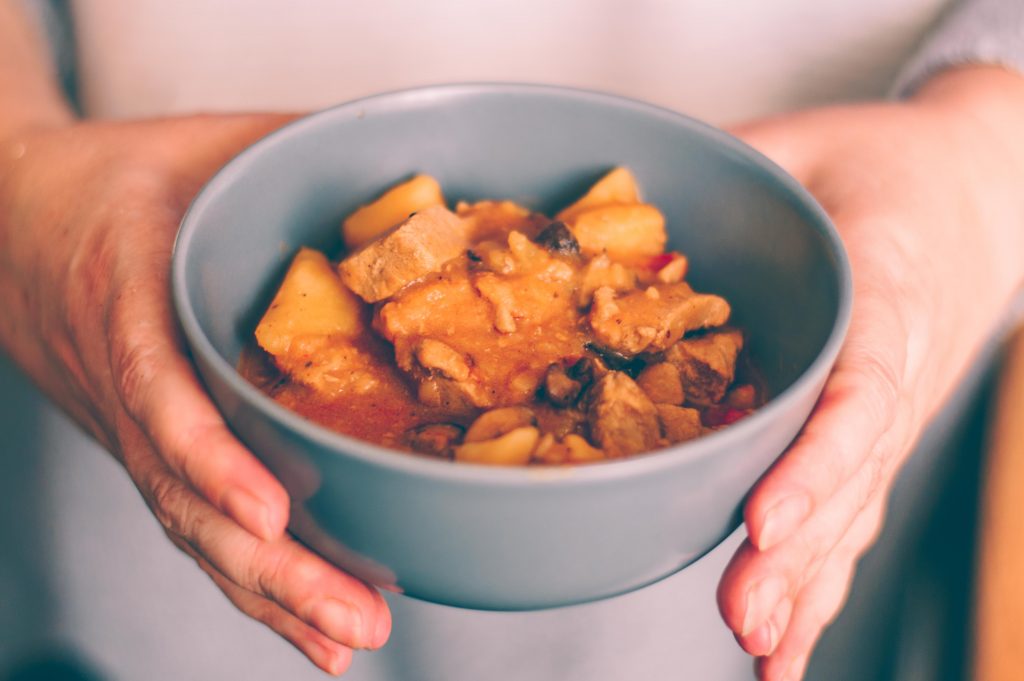
- Zharkoye
A variation of this dish can be found in cuisines all over the world: goulash in Hungary, azu in Tatarstan, and yakhni in Turkey to name a few. Zharkoye is a hearty stew of meat, potatoes, and carrots baked in a pot.
- Golubtsi
Golubtsi are cabbage leaves stuffed with meat and wrapped to look like pockets. As it always happens, there is more than one recipe for golubtsi. My mom, for example, makes them with Napa cabbage instead of regular cabbage as its leaves are more tender.
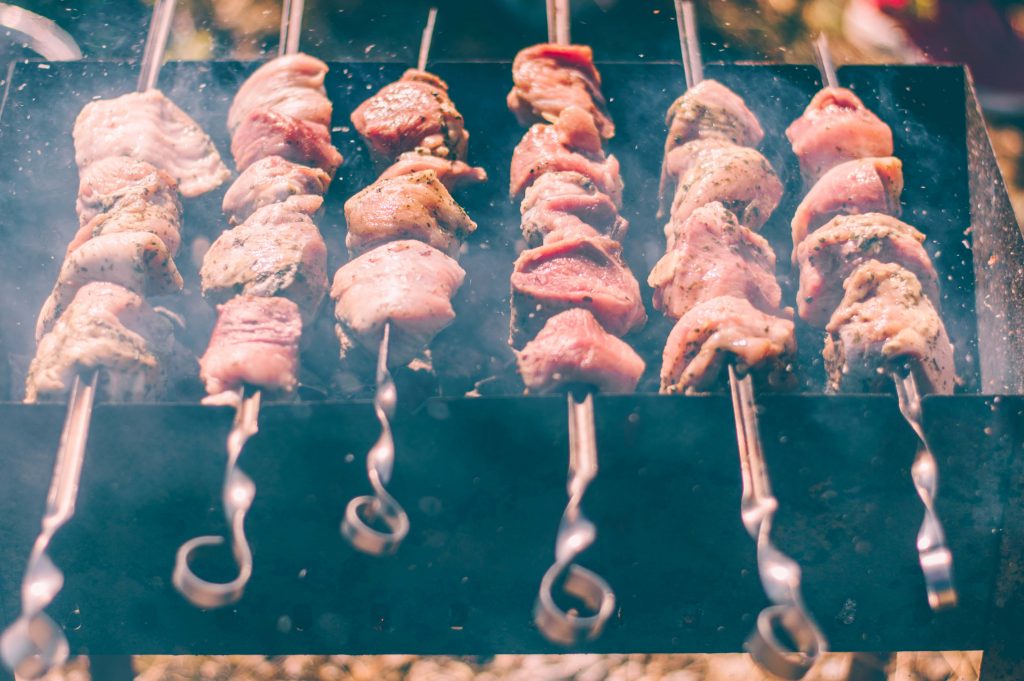
- Shashlik
Not just a dish, but a whole experience, shashlik must be consumed in summer or early autumn, preferably in a forest or by the lake. Shashlik is Russian barbecue. Pieces of meat are marinated, put on metal skewers, and cooked over hot coals.
There are some restaurants that make shashlik in-house, but it’s really not the same. If you have Russian friends, ask them to take you to a dacha (country house) and make shashlik the proper way.
Baked Goods
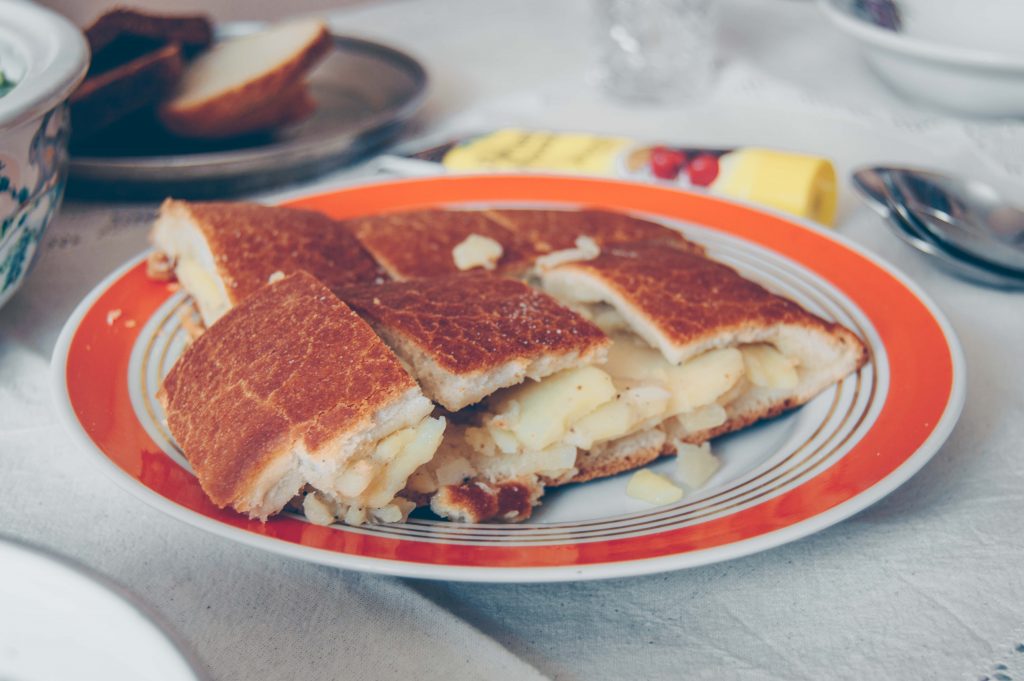
- Pirogi
Do not confuse with Polish pierogi. Pirogi are Russian covered pies. They are usually made with yeasted dough and stuffed with everything from meat to fish to vegetables to fruits.
Some varieties have their own names. For example, a dome-shaped pirog stuffed with chicken is called kurnik. Pirog with a complex filling that contains many ingredients is called kulebyaka.
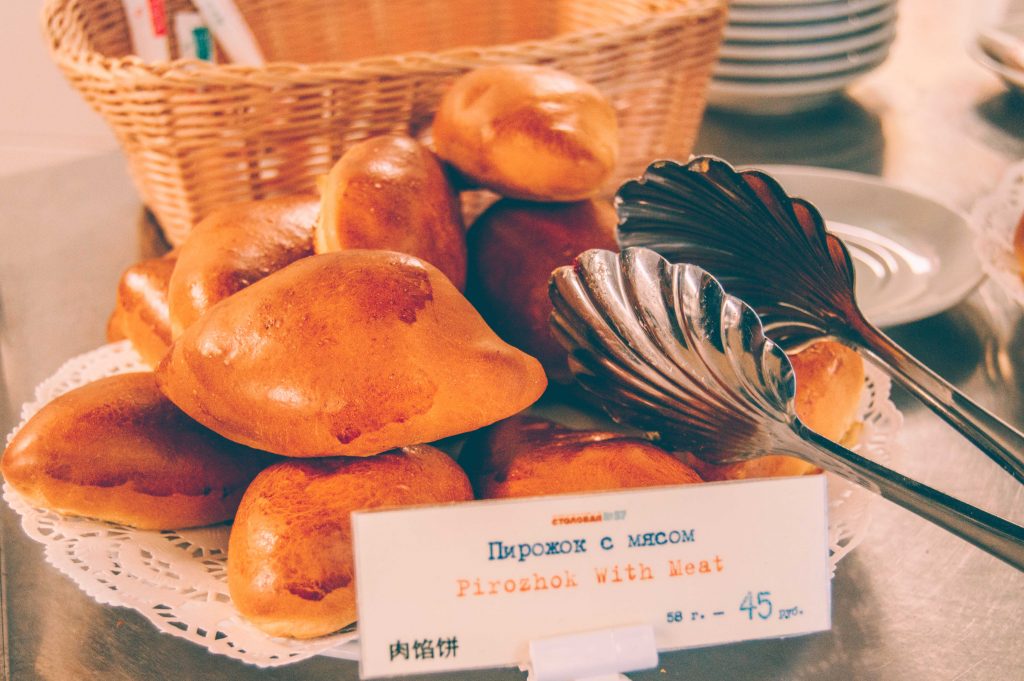
- Pirozhki
The word pirozhki is a diminutive of pirogi. So pirozhki are essentially smalls pies. Like pirogi, pirozhki are made with yeasted dough. Unlike pirogi, they can be not only baked, but fried on a pan too. The fillings vary from meat to egg and rice to liver to berries and beyond.
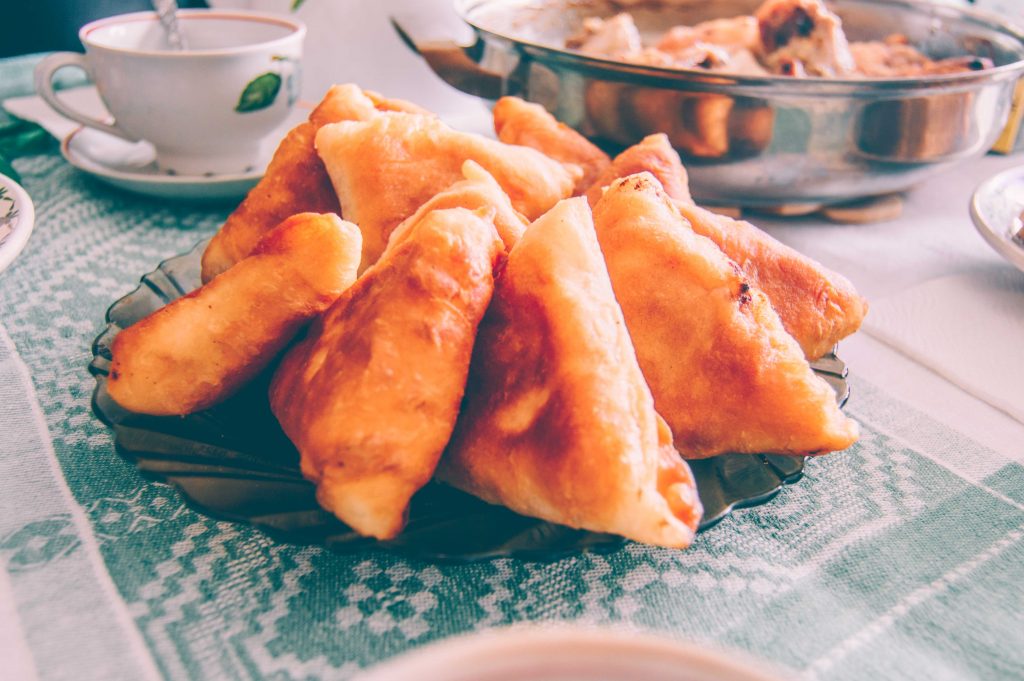
- Chebureki and Belyashi
Chebureki come from Crimean Tatar cuisine. They are crescent-shaped pastries filled with ground meat (often lamb) and deep-fried.
Now, belyashi come from the Republic of Tatarstan. Like chebureki, they are deep-fried and stuffed with meat. The difference is that they are round- or triangular-shaped and have a tiny opening. While frying belyashi the cook pours boiling oil inside the opening to make the pastries juicy and fatty.
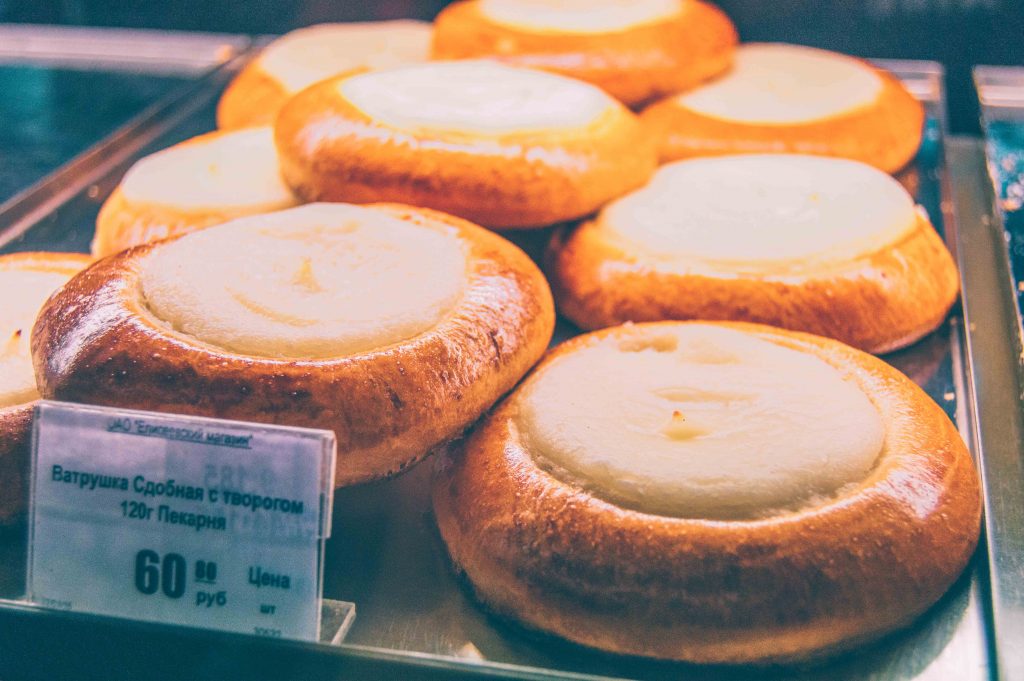
- Vatrushka
Vatrushka is a sweet pastry shaped as a round of dough with cottage cheese in the middle. Sometimes raisins are added to the filling.
Sweets
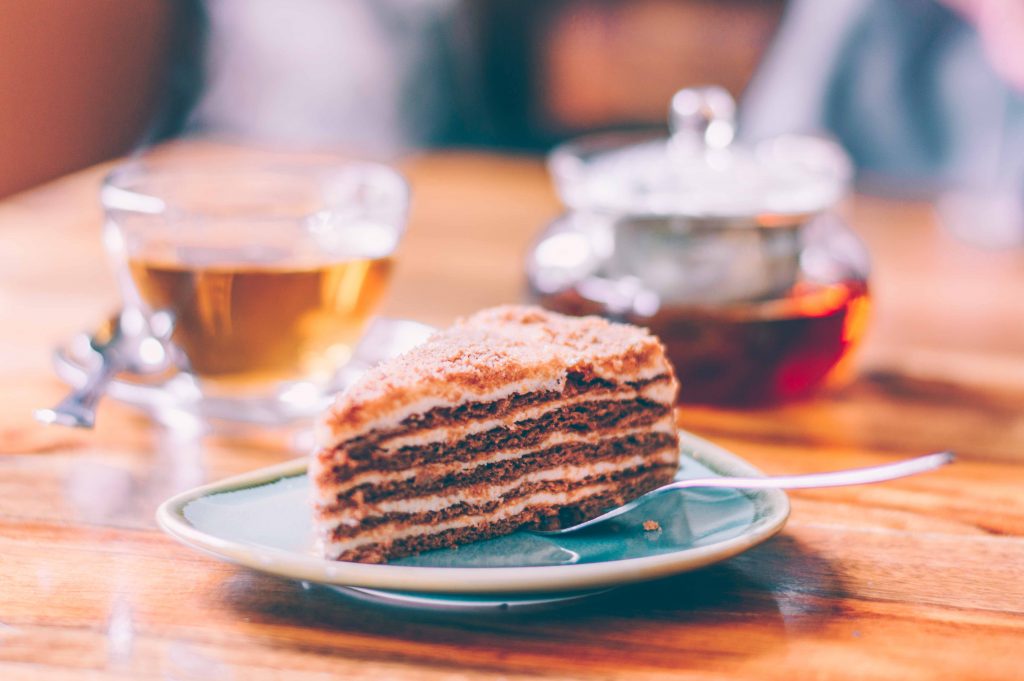
- Medovik
Medovik is a honey cake with sour cream frosting. Made of paper-thin layers soaked in tangy sour cream filling, medovik is super soft and mildly sweet.
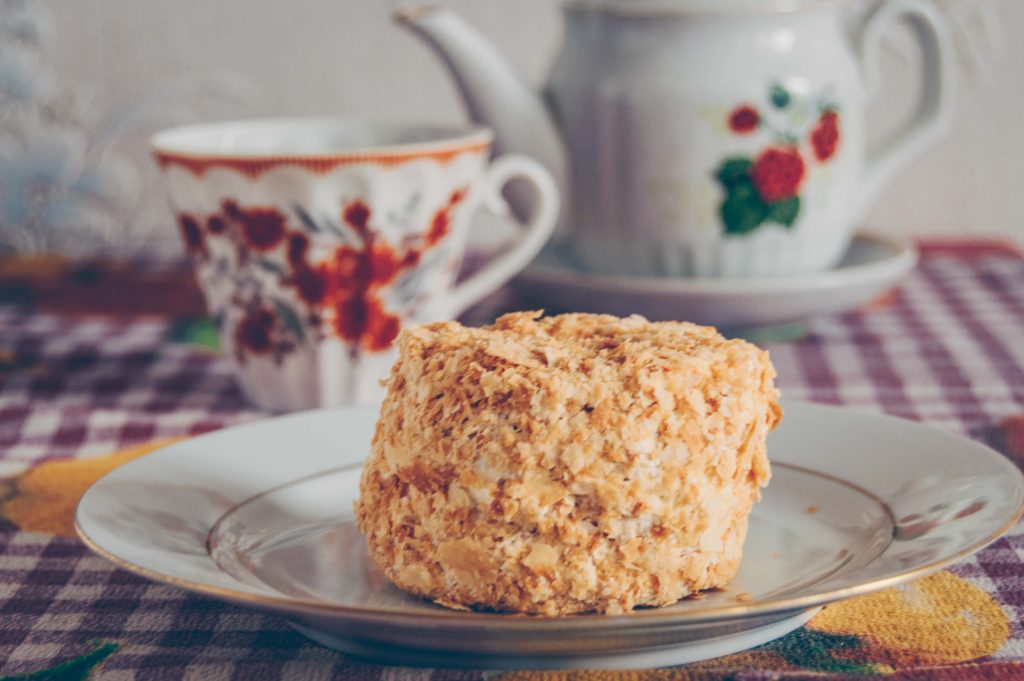
- Napoleon
Although named after Napoleon Bonaparte, this layered cake is a Russian creation. The legend goes like this: in 1912 when 100th year anniversary of victory over Napoleon was widely celebrated in Russia, a triangle-shaped pastry was invented by Moscow chefs. The shape was reminiscent of Napoleon’s hat which is where the name came from.
Over the years, Napoleon grew in size from a pastry into a cake. The original shape was lost, giving way to a more practical square, but the name stuck. If you ask me about the taste, Napoleon is similar to French mille-feuille.
- Ptichye moloko
Translated directly, ptichye moloko means “bird’s milk”. But fear not, there are no funky ingredients in this cake. Only the softest, fluffiest soufflé, layers of sponge cake, and chocolate ganache. Apart from cake, there are also candies with the same name.
- Sushki and Baranki
Sushki are small rings of bread. Ok, let me try again. Sushki are tiny crunchy rounds with a hole in the middle. Still confusing? Sushki come from the Russian word sushit which means “to dry”. They are a bit hard and, therefore, best enjoyed with tea (you can even dip them in!).
Now, baranki are like bigger and softer sushki. Some Russian restaurants serve sushki and baranki as a compliment with tea.
- Pryaniki
Pryaniki are Russian cookies made with honey and spices. Sometimes translated as “Russian gingerbread”, pryaniki rarely have any ginger in them, which is why this name is misleading.
While they used to be home-made, nowadays pryaniki are mass-produced and you can buy a pack at a supermarket. The most famous pryanik comes from the city of Tula and is an awesome souvenir to bring home. Pryaniki with a glass of warm milk are why life is worth living.

- Russian candies
Last, but not least in the category of sweets are candies. When my parents or friends from Russia come to visit me in Germany (and before that in USA, and before that in Sri Lanka) I always ask them to bring me candies. This is how good they are.
Not all candies are made equally, so you have to look for the following names: Метелица (Metelitsa), Красный Мак (Krasniy Mak), Мишки на Севере (Mishki na Severe), Белочка (Belochka), Петушок (Petushok), Каракум (Karakum), Коровка (Korovka). Сandies are sold in supermarkets by weight.
Drinks
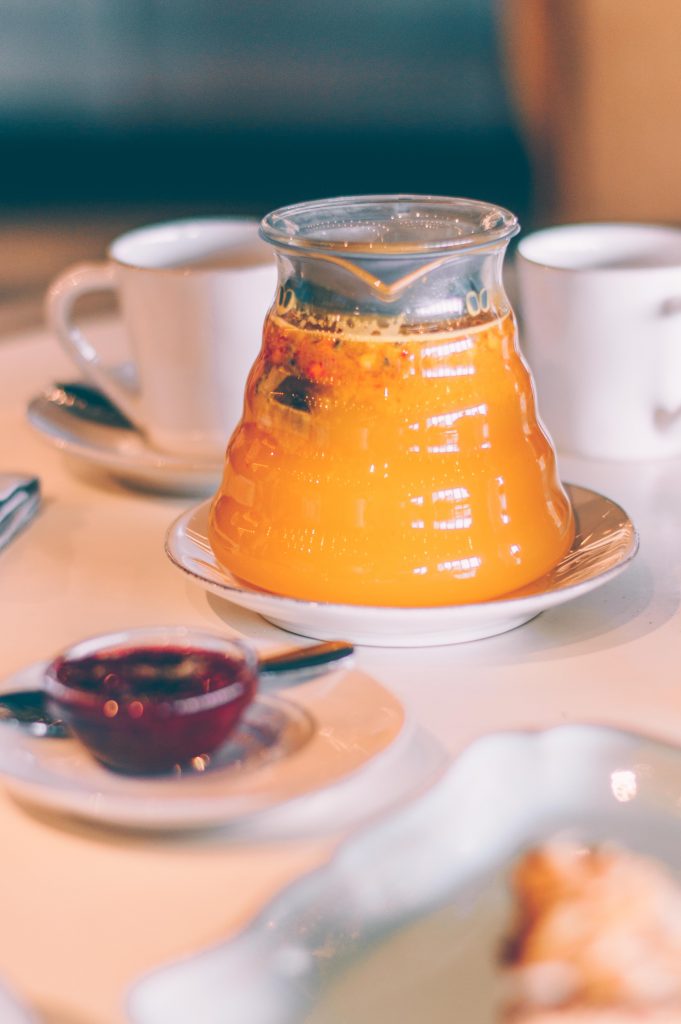
- Tea with homemade jam
If you think Russians’ favorite drink is vodka, you are wrong. It’s tea. My mom can easily drink six to eight cups a day and that is not unusual. A lot of Russian restaurants make their own tea infusions with local leaves, berries, and herbs. Think: black tea with sea buckthorns, tea with herbs from Altai region, or wild strawberry tea.

- Kvas
Kvas is a fermented drink made of rye bread which is best enjoyed cool during hot summer months. Kvas is one of those drinks that people either passionately love or hate. The closest thing taste-wise is kombucha, but I’d say kvas is less sweet. Apart from drinking it on its own, we also use kvas to make okroshka (I mentioned it in the soup section).
- Kompot and Mors
Both kompot and mors are summer drinks made with fruits and berries, but there’s a difference in preparation technique. Kompot is made by boiling fruits in water. Mors is made by squeezing juice out of berries and mixing it with water. Kompot can be served both warm and cold, while mors is only consumed cold. Best place to try both is a traditional Soviet canteen, like Stolovaya №57 at GUM.
- Kisel
Kisel is yet another fruit drink. It is prepared with corn or potato starch which makes it thick and gooey.
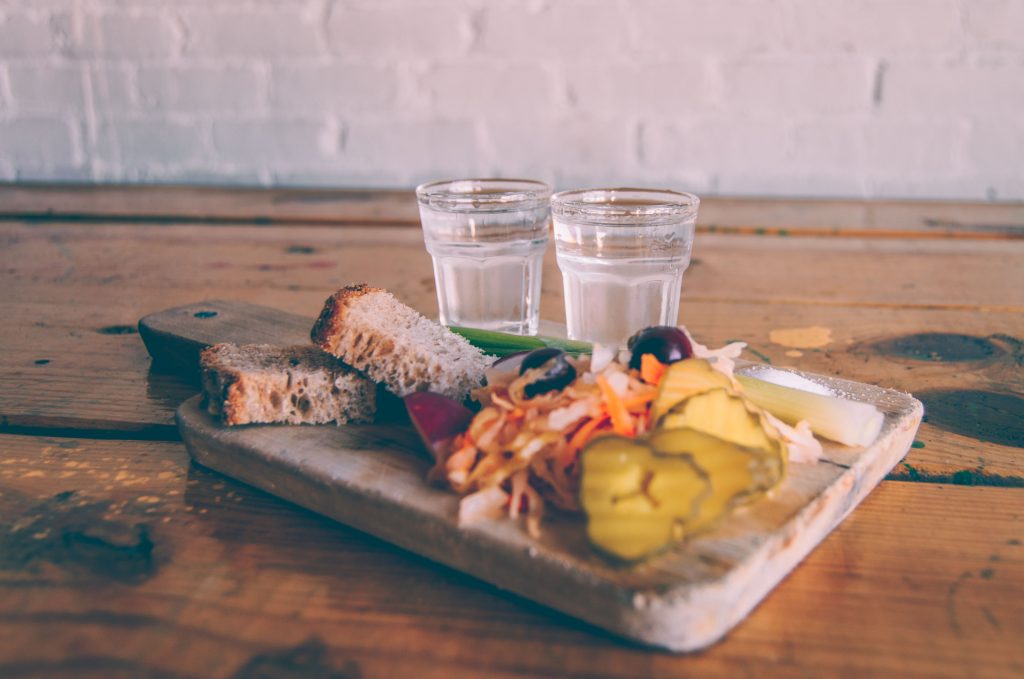
- Vodka
As much as I hate perpetuating stereotypes, this guide would be incomplete without vodka. My drinking days are long gong, especially with the arrival of my baby. But my friends recommend you try Beluga and Russkiy Standart.
- Nastoika
For a more fun approach to drinking vodka, try nastoika, or home-made infusions. Russian nastoika can be made with a variety of local herbs and berries. Think: black current, cranberry, pepper, pine nut, and even horseradish.
* * *
I hope this guide to Russian food will be helpful in planning your trip! There are dozens (if not hundreds) more Russian dishes you might encounter if you travel outside of Moscow and Saint Petersburg which I highly recommend.
Let me know in comments if you tried some of these dishes, especially the weird ones like kholodets, okroshka or herring under fur coat. Did you love them? Hate them? I’d love to hear!
Want to read more about Russia?
I have a few posts on my blog about Russian food, culture, and traditions. If it’s your first trip, read my 50 important tips for the first-time travelers.
If you are planning to visit Moscow, here are my favorite restaurants that serve Russian food in the capital. You should also visit GUM which is a perfect place for foodies. And don’t miss Eliseevsky, one of the most incredible supermarkets in the world. If you are traveling to Russia’s cultural capital, here are the restaurants I loved in Saint Petersburg.
Want to learn more about hearty Russian food and enigmatic Russian soul? I have an article about our enormous love for mayo, our tradition of spending time with family in the kitchen, and a few more personal posts about life as an immigrant and being bilingual.




